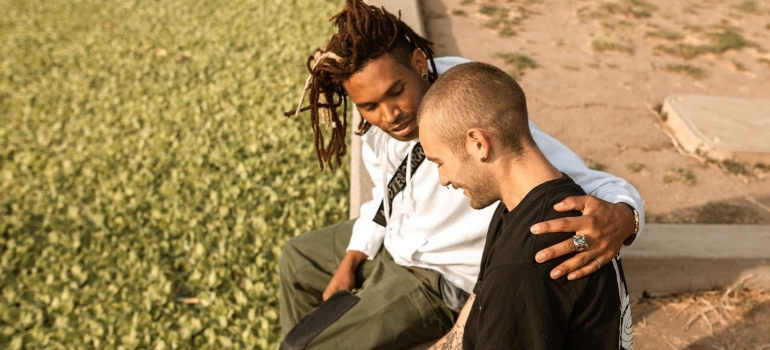Addiction can tear apart lives and relationships, leaving loved ones unsure of how to help. Staging an intervention may seem daunting, but it can be a powerful step toward recovery. It’s essential to know how to conduct an addiction intervention with care and preparation. This process involves gathering a supportive team, creating a plan, and offering the individual a chance to seek help without judgment. Whether you’re helping a friend or family member, the goal is to encourage them to enter treatment. There are many options available, including rehabs in WV, that provide the necessary support for recovery. When conducted properly, an intervention can be a turning point. However, there are right and wrong ways to approach it. By understanding what makes an intervention successful and what to avoid, you’ll be better prepared to guide someone toward a healthier path.
What’s a Drug Addiction Intervention?
A drug addiction intervention is a structured conversation where loved ones confront someone about their substance abuse. The main goal is to help the person recognize their addiction and accept the need for treatment. Unlike casual discussions, an intervention is carefully planned to ensure the conversation stays focused and productive. It provides a safe, non-judgmental space for family and friends to express their concerns and offer support. The individual struggling with addiction is often unaware or in denial about the severity of their problem.

During an intervention, each participant shares how the addiction has impacted them and the person’s life. The tone should be compassionate, not confrontational, focusing on the benefits of seeking treatment. In many cases, professional interventionists or therapists are involved to help mediate the process.
The hope is to encourage the person to enter a treatment program, such as a drug rehab in WV, where they can receive the support they need. Interventions are not about blaming or shaming the individual but about offering a clear path to recovery. By the end of the intervention, the goal is for the person to understand the consequences of their addiction and feel supported in deciding to seek help. When done correctly, an intervention can be a pivotal moment in a person’s journey toward sobriety, potentially saving their life.
The Importance of Planning an Intervention
Planning an intervention is crucial for its success. Without a well-thought-out plan, the conversation can easily spiral into emotional outbursts, confusion, or even defensiveness from the person struggling with addiction. When emotions run high, it’s easy to lose sight of the goal, which is to encourage the individual to seek treatment. Careful planning helps ensure that the focus stays on the person’s well-being and the message remains clear.
A good plan starts with gathering information about the person’s addiction, understanding their triggers, and identifying possible treatment options, such as individual therapy for addiction. The next step is selecting the right group of people to participate. These should be individuals who can remain calm, supportive, and constructive during the intervention. Each person involved should know their role and what they will say beforehand.
How to conduct an addiction intervention? Planning also involves setting the right time and place. A neutral, quiet location can help the person feel safe and less threatened. Lastly, having a plan in place ensures you have a clear goal, which is to motivate the person to get the help they need. By organizing every detail, you can approach the intervention with confidence, knowing you’ve created the best possible environment for a positive outcome. Thoughtful planning increases the likelihood of the person accepting the offer for help and taking the first step toward recovery.

How to Conduct an Intervention
Conducting an addiction intervention requires careful steps to ensure the person feels supported and encouraged to seek help. The process involves assembling a team, planning, gathering information, and maintaining compassion throughout the conversation. Here’s a guide to help you conduct a successful intervention that leads to recovery.
Gather a Team
The first step in any intervention is gathering a small group of people who care deeply about the person struggling with addiction. This group should consist of close family members, friends, or even coworkers who have been directly affected by the individual’s addiction. Each person should remain calm and focused, avoiding anger or frustration. Having the right team ensures that the conversation stays on track and that the individual feels loved, not attacked.
It’s important to avoid having too many people involved, as this can overwhelm the person. A smaller, well-selected group increases the chances of the person being receptive. Each team member should prepare ahead of time, knowing what they will say and how they will approach the subject.
Make a Plan
Before the intervention, gather as much information as possible about the individual’s addiction. Understand what substances they are using, how long they have been using them, and how drugs alter your emotional state and physical health. Being well-informed allows you to speak knowledgeably and compassionately during the intervention.
This research also helps when discussing treatment options. Different addictions require different approaches, so knowing the type of substance they are using can help tailor the treatment plan. Whether it’s alcohol, opioids, or something else, understanding the impact of the drug will allow you to offer the best possible solution during the intervention.

Focus on Compassion and Understanding
An intervention should never feel like a confrontation. Instead, focus on compassion and understanding. Express your concern about how the addiction has affected the person’s life and the lives of those around them. Avoid blame or judgment, as this will likely lead to defensiveness. Compassionate language is key to encouraging the individual to seek help.
Using “I” statements is a great way to frame your concerns. For example, “I’m worried about how much you’ve been drinking, and I miss spending time with you.” This approach is less accusatory and shows that you’re focused on the person’s well-being, not attacking their character.
Set Boundaries
One important part of any intervention is setting clear boundaries. Explain the consequences of their refusal to seek treatment. For example, you might say that financial support will end, or they will no longer be able to live at home unless they agree to enter a program. While it’s difficult, setting these boundaries helps the person understand the seriousness of the situation and the impact of their addiction on their loved ones.
In some cases, family therapy for addiction may also be necessary to address issues within the family dynamic that contribute to or enable the addiction. Setting boundaries ensures that the person knows their choices have real consequences, and they must take responsibility for their recovery.
Seek Professional Help
If you’re unsure about how to conduct an intervention on your own, seeking professional help is a smart move. Intervention specialists or addiction counselors can guide the process, ensuring it remains focused and productive. These professionals are trained to handle sensitive situations and can help mediate difficult conversations.
In some cases, they can also assist in finding the appropriate treatment centers such as
- Partial hospitalization program West Virginia,
- Intensive outpatient program West Virginia,
- Dual diagnosis treatment West Virginia
- or specialized cocaine rehab. Having a professional on board can increase the chances of a successful outcome, as they bring experience and objectivity to the situation.
Be Prepared For All Outcomes
Finally, it’s essential to prepare for any outcome. Even if you follow every step perfectly, the individual may still refuse help. While this is disappointing, it’s important to remain calm and remind them that the offer of support is always open. Be ready for the possibility that multiple interventions may be needed before they agree to treatment.
Remember that addiction is complex, and recovery is a long journey. It’s essential to stay hopeful and patient, offering ongoing support. Whether they agree to enter treatment right away or not, knowing they have loved ones who care can make a lasting impact on their decision to seek help in the future.
By following these steps, you can create a compassionate and structured environment for your loved one to take the first step toward recovery. While interventions are never easy, a well-planned approach increases the chances of success and gives a person a clearer path to overcoming its addiction.

Types of Intervention
There are different approaches to staging an intervention, and the method you choose can depend on the individual’s needs and the severity of their addiction. Each type of intervention has a unique structure, but all share the goal of helping the person recognize their addiction and seek help. Here are four common types of interventions:
1. Johnsons Model
The Johnson Model is the most traditional form of intervention. In this approach, family and friends surprise the person with an organized confrontation, addressing their addiction directly. Each participant takes turns expressing their concerns and explaining how the addiction has impacted them. The goal is to get the person to agree to treatment immediately. This model works well when the person is in deep denial about their addiction and may not be responsive to more collaborative methods.
2. The Invitational Model
Unlike the Johnson Model, the Invitational Model does not rely on surprise. Instead, the person is invited to a meeting where loved ones express their concerns more collaboratively. This approach reduces the pressure and allows the person to feel more in control. The setting is less confrontational, and the person has a chance to ask questions or voice their feelings during the discussion. This method can be particularly effective when dealing with someone who shows early signs of opiate addiction or is beginning to recognize the need for change but hasn’t fully committed.
3. The Systemic Model
The Systemic Model focuses not just on the person struggling with addiction but on the family as a whole. Addiction often affects family dynamics, and this method seeks to address those underlying issues. Rather than focusing solely on the individual’s behavior, the intervention explores how the family’s interactions may contribute to or enable the addiction. This model encourages healing within the entire family, leading to a more comprehensive solution. It’s particularly helpful when addiction has caused long-standing issues within family relationships.
4. The Field Model
The Field Model is typically used in more severe situations where the risk of violence or severe emotional outbursts is high. In this intervention, professionals such as therapists, social workers, or interventionists are present to guide the process and manage any crises that may arise. This model provides a level of safety and control that may be needed when there is a risk of harm to the person or others involved in the intervention.

What Not to Do In an Intervention
While planning how to conduct an addiction intervention, it’s just as important to know what to avoid as it is to know what to do. Here are some common mistakes that can undermine the process:
- Don’t confront without a plan – Confronting someone about their addiction without a clear plan can lead to chaos. Without a structured approach, emotions can take over, and the conversation may become heated. Always have a plan in place, including who will speak and what treatment options you will offer.
- Don’t let emotions control a room – It’s natural to feel anger or frustration when a loved one is struggling with addiction, but allowing emotions to control the intervention will likely push the person further away. Stay calm and focused on the goal—getting them into treatment. Express concern with compassion, not blame, to keep the person engaged.
- Don’t expect immediate acceptance – Even with the best preparation, don’t expect the person to agree to get help immediately. Addiction is a complex issue, and it can take time for someone to accept that they need treatment. Be patient and remind them that the offer for help, such as the option to attend rehab away from home, is always open.
- Don’t make it about yourself – The intervention should focus on the person struggling with addiction, not on how their behavior has affected you. While it’s important to express concern, avoid having a conversation about your own emotions or experiences. Keep the focus on the individual and their need for help.
- Don’t give up after one attempt – If the first intervention doesn’t succeed, don’t give up. It’s common for someone to reject help initially. Stay consistent and remind them that support is available whenever they are ready to accept it. Multiple interventions may be necessary before the person agrees to seek treatment.
How to Conduct an Addiction Intervention
Knowing how to conduct an addiction intervention can be the first step toward helping someone regain control of their life. Planning carefully, gathering the right team, and approaching the situation with compassion increases the chances of success. While the process can be challenging, patience and persistence are key. Remember that recovery doesn’t happen overnight, and setbacks are part of the journey. If done correctly, an intervention can open the door to treatment and lasting change. Offering support and understanding will help guide your loved one toward the help they need



